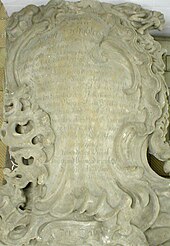Johann Baptista Lauggas
Johann Baptista Lauggas (* 1708 in Merano , † 1768 in Öhringen ; also Johann Baptist Lauggas ) was a German sculptor of the rococo . He was mainly active in the Hohenlohe royal seat of Öhringen and was a court sculptor there .
Life
Lauggas was born in Merano and baptized on April 21, 1708. Nothing else is known about the first 33 years of his life.
In 1741 Lauggas married Maria Sophia Landbeck from Öhringen , presumably of Lutheran faith, and became a citizen of Öhringen. The marriage had four children, two of whom died early. The son Franz Heinrich studied theology and died in 1789, the daughter Anna Regina Dorothea married the Öhringer Hof gürtler Ziegler in 1768 .
Lauggas was active in Öhringen under the Hohenlohe-Oehringischen princes Johann Friedrich II. And Ludwig Friedrich Carl. From 1747 he called himself a court sculptor . In 1752 he bought the 200-year-old house at Kirchbrunnengasse 25, where he lived until his death in 1768. On October 4, 1768 he was buried in the Öhringen cemetery.
His widow lived in the house until 1780. After numerous changes of ownership, it was demolished around 1990 and replaced by a new building based on its predecessor. The Portal with a designed by Lauggas Supraporte was taken there.
plant
Lauggas' work includes stone carving , stone carving , wood carving and gilding, and the occasional painting . From 1746 to 1749 he played a key role in the baroque design of the collegiate church in Öhringen . A ceiling decoration in the nave of the church carved out of wood and showing three angels comes from him.
Some of the tombs created by Lauggas have been preserved, some of them of a simple type such as the tomb of the nun Sophia Juliana von Wöllwarth from 1748 in the collegiate church of Oberstenfeld , some with splendid rococo shapes such as the tomb of Hohenlohe Chancellor Bernegger from 1753 in the side chapel of the Öhringen collegiate church , the tomb of Heilbronn Mayor Johannes Schübler from 1759 (today in the Lapidarium of the Heilbronn City Archives ) and the tomb of Mayor Johann Peter Muth from 1765 in the St. Anna cemetery chapel in Öhringen. The grave of the dean Johann Michael Heinle, who died in 1759, is also located in the Öhringen cemetery chapel.
Other works:
- Supraporte with a Trinity motif on his house in Öhringen
- Epitaph of Count Johann Friedrich zu Castell-Rüdenhausen from 1751 in the choir of the Evangelical Church of St. Peter and Paul in Rüdenhausen
- Double grave of two brothers from Heilbronn, the municipal syndic Georg Heinrich Geiling (1698–1756) and the city schoolmaster Johannes Georg Geiling (1696–1757), today in the Heilbronn Lapidarium
- Stone epitaph of the chief bailiff Urban Immanuel Keller († 1766) in the Brackenheimer Johanniskirche
- Stone epitaph for Lukas Samuel, Dietrich Christoph, Marie Luise and Luise Margarethe Koch, set in 1742 by Vogt Christoph Koch and his wife Dorothea
literature
- Moriz von Rauch : Lauggas, Johann Baptista . In: Hans Vollmer (Hrsg.): General lexicon of fine artists from antiquity to the present . Founded by Ulrich Thieme and Felix Becker . tape 22 : Krügner – Leitch . EA Seemann, Leipzig 1928.
- Öhringen town houses. Volume II: Büttelbronnerstraße - Schillerstraße - Kottmannstraße - Bahnhofstraße - Bismarckstraße - Schafgasse - Haagweg - Schulgasse - Kirchbrunnengasse - Walk - Hunnenstraße - Karlsvorstadt. Geiger, Horb am Neckar 2000, ISBN 3-89570-667-1 , pp. 129-131.
Individual evidence
- ↑ illustrations at picture index .
- ↑ Information on the tomb at the Heilbronn City Archives (accessed on November 10, 2012).
- ↑ Information on Johann Peter Muth (accessed on November 10, 2012).
- ↑ Öhringen. City and pen. Published by the city of Öhringen. Thorbecke, Sigmaringen 1988, ISBN 3-7995-7631-2 ( Research from Württembergisch-Franken. Volume 31), Fig. 128 after p. 192.
- ↑ Öhringen. City and pen. Published by the city of Öhringen. Thorbecke, Sigmaringen 1988, ISBN 3-7995-7631-2 (= research from Württembergisch-Franken. Volume 31), Fig. 127 before p. 161.
- ↑ Rüdenhausen at kulturpfad-grafen-castell.de (accessed on November 10, 2012)
- ↑ Information on the tomb at the Heilbronn City Archives (accessed on November 10, 2012).
- ^ Adolf Schahl: The Johanniskirche in Brackenheim. Zabergäuverein, Güglingen 1981 (= Zabergäuvereins magazine. Issue 1/2, year 1981), pp. 34–35.
- ^ Adolf Schahl: The Johanniskirche in Brackenheim. Zabergäuverein, Güglingen 1981 (= Zabergäuvereins magazine. Issue 1/2, year 1981), p. 39.
| personal data | |
|---|---|
| SURNAME | Lauggas, Johann Baptista |
| ALTERNATIVE NAMES | Lauggas, Johann Baptist |
| BRIEF DESCRIPTION | German sculptor of the Rococo |
| DATE OF BIRTH | baptized April 21, 1708 |
| PLACE OF BIRTH | Meran |
| DATE OF DEATH | buried October 4, 1768 |
| Place of death | Öhringen |

